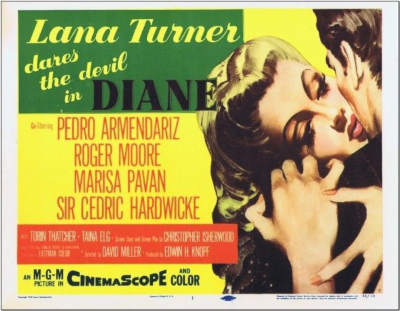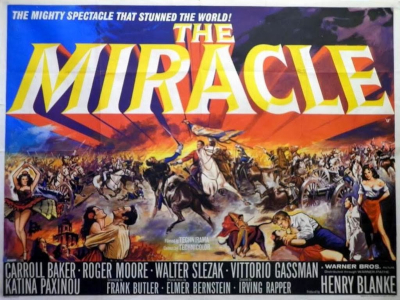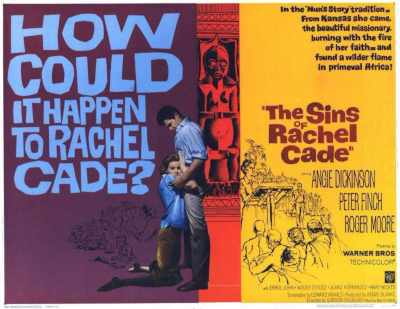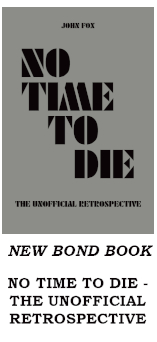|
Moore Not Less - Diane, The Miracle, The Sins of Rachel Cade

Diane
is a 1956 historical drama about the life of Diane de Poitiers. Diane
de Poitiers was a noblewoman and courtier at the courts of kings
Francis I and his son - Henry II. She became notorious as the latter's
favourite and developed much influence and power at the French Court.
The film was directed by David Miller and written by Christopher
Isherwood and John ErskineThe
leading lady is Lana Turner, a huge Hollywood star but now slightly on
the downward slope. It was the last film of Turner's MGM contract.
Years before, Turner had famously been spotted by a Hollywood reporter
sipping Coke in a cafe after skipping a typing class in school. He was
astonished by her beauty and poise and passed her details onto talent
agent (and former Marx Brothers star) Zeppo Marx. Turner was soon a
Hollywood legend and film star. Diane
was Roger's final film as part of his MGM contract and he takes on the
part of Prince Henri. Co-star Pedro Armendáriz would go on to become
well known to James Bond fans for his role as Kerim Bey in From Russia
with Love with Sean Connery. Diane was not a huge financial success but
the production values of the film were praised and it served as a
respectable last hurrah for Lana Turner's MGM years.Diane
is rather loose with historical fact but is colourful entertainment
with an interesting cast and a great eclectic score by Miklós Rózsa
full of melodies and fanfares. The director David Miller had a long and
productive career that would include Lonely Are the Brave in 1962. In
1949 he had even directed an unofficial Marx Brothers films (of sorts)
when he made Love Happy with Harpo Marx. Chico and Groucho were roped
into proceedings and made an appearance. The
costumes in Diane, by Walter Plunkett of Gone with the Wind, are
suitably opulent and a lot of fun even if they might not satisfy the
most rigourous historians. Lana Turner gives a seasoned performance as
Diane de Poitiers. It's maybe not her most natural display of acting
but she's an old pro by this stage of her career and commands the
screen. Roger is very dashing
and handsome as Henri although he doesn't seem completely comfortable
in period clobber. He and Turner work together relatively well and do
their best to stir some passion into the picture. The age difference
between the characters is less of a factor in this interpretation but
Roger does look very baby-faced and young compared to the statuesque
Turner. The film is a trifle
stagey at times and rather melodramatic in the style of the era but
these are minor criticisms as the costumes and spectacle washes over
the screen and makes one more inclined to gloss over the dated and
ahistorical elements. The supporting cast is well chosen - especially
Marisa Pavan as Catherine de' Medici. The relationship between Diane de
Poitiers and Catherine de' Medici is one of the key components to the
film and the historical source material. Cedric Hardwicke is also solid
as Ruggieri. Diane is a little
hokey at times in its depiction of history but the production values
are intricate and handsome and the music cues are very stylish. It's an
entertaining - and very Hollywood - historical drama from the era.
While one would not call the film a classic by any means, Diane is
certainly worth a look for backdrops, costumes, the unique pairing of
Lana Turner and Roger Moore.
The
Miracle is a 1959 film directed by Irving Rapper is adapted from The
Miracle (1911) by German playwright Karl Vollmoeller. Volmoeller based
the play on a Middle Ages legend of a Virgin Mary statue replacing a
nun who flees a convent with a knight. The film was supposed to be made
in the 1940s but was long delayed and only arrived in 1959. The story
here moves the legend to the Napoleonic era and has Carroll Baker as
the lead. Baker, a famous sex symbol of the era, (unwittingly) created
controversy in Elia Kazan's suggestive Baby Doll a few years before. It
was speculated that her playing a postulant in a convent in a moral
message film was an attempt to dampen the controversy that still
lingered from censorious religious groups. She didn't want to be
typecast. The film was intended
as a Bette Davis vehicle but she wasn't interested. Roger's part as a
British officer was offered to Dirk Bogarde but he wasn't interested
either - suggesting to the studio that Roger play the role instead.
When Roger later tried to personally thank Dirk Bogarde for suggesting
him he found it impossible to get a meeting with the reclusive actor!
The Miracle met with a lukewarm reception both from audiences and
critics. It wasn't helped by opening against Ben-Hur and also suffered
in comparison to Audrey Hepburn's The Nun's Story. Teresa
(Carroll Baker) is a nun working in a Spanish convent who falls for
British soldier Captain Michael Stuart (Roger) during the Napoleonic
wars. When she leaves the convent to follow him, a Virgin Mary statue
takes her abandoned habit and replaces her. Meanwhile, Teresa is
distraught when Michael is believed to have been killed and begins a
series of encounters with numerous characters. But is Michael really
dead? The Miracle is a colourful
but cheesy would be epic that probably works best as a guilty pleasure
rather than a particulary good film. The religious subtext is not very
subtle but there is enough spectacle thrown at the screen to keep one
distracted most of the time. The film is awash with singing and dancing
and the scenes with soldiers marching into battle or riding horses are
pretty good with enough extras deployed to give the picture the sheen
of a relatively expensive production. The atmosphere is rather cliched
given the setting and there is bullfighting and Flamenco music,
dancing, gypsies.Carroll Baker is
clearly not the most obvious person to cast as a nun and occasionally
appears somewhat bewildered by the film but she makes for a handsome
couple alongside the baby-faced Roger. Roger is suitably dashing as the
captain and while he too also takes on an occasional look of confusion
at some the lines he is asked to dispense one can see how he managed to
carve out a long career with his good looks and ability to play
stalwart heroes. The most salient problem the film wrestles is the
inconsistent tone. It never seems to settle down into any one thing.
Sometimes the film is playful and light and then it all suddenly seems
to be taking itself very seriously. Baker
is always watchable though as Teresa's baroque adventures see her meet
all manner of characters and even try her hand at singing. She comes to
believe she is cursed and will spell doom for any man she chooses. The
direction by Irving Rapper borders on the histrionic but he manages to
keep this frequently bonkers - if conservative in message - production
chugging along. Walter Slezak also gives the film a much needed goosing
as the gyspy Flaco. The Miracle is not a great film but it is a rather
curious and eccentric one that is probably worth experiencing at least
once. 
The
Sins of Rachel Cade (1961) was part of Roger's contract with Warner's
and saw him appear with Angie Dickinson and Peter Finch. Well, Roger
was shooting the television show The Alaskans and only arrived on the
set of The Sins of Rachel Cade as Finch was preparing to leave so they
didn't spend much time together. Roger's friend Gordon Douglas directed
the picture. The film was written by Charles Mercer (from the novel by
Edward Anhalt). The Sins of Rachel Cade is a so-so melodrama that is
competent enough but perhaps not the most memorable of the early films
that Roger acted in. At the dawn
of World War 2, missionary Rachel Cade (Angie Dickinson) travels to the
Belgian Congo but finds herself in charge of the local mission when the
presiding doctor dies. Rachel is soon up to her neck in work and
troubles and has conflicts of the heart when administrator Colonel
Henry Derode (Peter Finch) takes a shine to her and then when she takes
a shine to the dashing downed RAF pilot Paul Wilton (Roger)...The
Sins of Rachel Cade is a very late fifties/early sixties soap opera-ish
drama with the Belgian Congo quite obviously a few sets out the back of
the Warner's lot rather than a real jungle. Some stock footage from The
Nun's Story was also used in the film. Angie Dickinson is clearly a
little too film star glamerous to ever completely convince as an
unworldly missionary but she does relatively well with the part and
Peter Finch underplays his role to decent effect as Derode. Derode
comes across as a very human character doing his best in this
complicated outpost now that the geopolitics of the world have changed.Dickinson
goes around saving people and doggedly tending to her work and a
handsome RAF American volunteer pilot falls out of the sky and ignites
her supressed desires and passions. It's hard to take Roger seriously
as an American but he certainly looks the part of a cinematic pilot and
he and Dickinson make a great looking romantic pair. Roger
disappears from the narrative but his visit to the jungle has far
reaching consequences for Rachel and supplies the soaper melodrama that
chugs the film along through some dull spells. The Sins of Rachel Cade
- at two hours long - could have done with losing twenty or so minutes
along the way and Finch's character probably could have more more
definition. The theme of
personal desire and spiritual calling and the tension between them is
never entirely fleshed out or given anything more than a superficial
Hollywood treatment but the film is watchable enough even if we can't
completely accept Angie as a prim missionary with matters of the heart.
The direction is solid but not especially inventive although the music
cues by Max Steiner are good. Look out for some interesting supporting
actors here - especially Mary Wickes and Scatman Crothers. Mary Wickes
is a help in getting the film through some lulls. The Sins of Rachel
Cade is a modest film that is by no means bad but it certainly doesn't
lodge in the memory much after you've seen it either.- Jake
© 2024
Alternative 007
|



|






